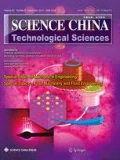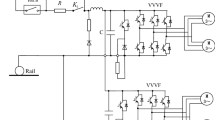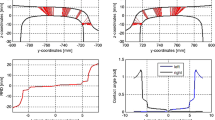Abstract
Based on the theory of vehicle-track coupled dynamics and gear system dynamics, a locomotive-track coupled spatial dynamics model is established by considering the dynamic effects of the gear transmission system. The vibration responses of a locomotive’s major components are then simulated using three locomotive-track models, namely the proposed dynamics model with the gear transmissions, a locomotive-track coupled dynamics model that considers the traction motor, and the classical Zhai’s model. The locomotive dynamic responses of the three models are extracted and compared to reveal discrepancies between them so as to explore the dynamic effects of the power transmission system and clarify potential applications of these models. The results indicate that the dynamic effects of the gear transmissions have a negligible influence on the lateral vibrations of the locomotive components. However, they have obvious effects on the vertical and longitudinal vibrations of the wheelset and the traction motor. Another advantage of the locomotive dynamics model that considers the dynamic effects of the gear transmissions is that the dynamic performance of the drive system can be assessed in the vehicle vibration environment. This study provides theoretical references that can assist researchers in choosing the most appropriate locomotive dynamics model according to their specific research purpose.
Similar content being viewed by others
References
Hirotsu T, Kasai S, Takai H. Self-excited vibration during slippage of parallel Cardan drives for electric railcars. JSME Int J, 1987, 30: 1304–1310
Yao Y, Zhang H J, Li Y M, et al. The dynamic study of locomotives under saturated adhesion. Vehicle Syst Dyn, 2011, 49: 1321–1338
Kim W, Kim Y, Kang J, et al. Electro-mechanical readhesion control simulator for inverter-driven railway electric vehicle. In: Proceedings of the Thirty-Fourth IAS Annual Meeting IEEE Industry Applications Conference. Phoenix, 1999
Zobory I. Dynamic processes in the drive systems of railway traction vehicles in the presence of excitation caused by unevennesses in the track. Vehicle Syst Dyn, 1985, 14: 33–39
Winterling M, Tuinman E, Deleroi W. Attenuation of ripple torques in inverter supplied traction drives. In: Proceedings of the 17th International Conference on Power Electronics and Variable Speed Drives. London, 1998
Zhai W, Wang K, Cai C. Fundamentals of vehicle-track coupled dynamics. Vehicle Syst Dyn, 2009, 47: 1349–1376
Liu P, Zhai W, Wang K. Establishment and verification of threedimensional dynamic model for heavy-haul train-track coupled system. Vehicle Syst Dyn, 2016, 54: 1511–1537
Simson S A, Cole C. Simulation of curving at low speed under high traction for passive steering hauling locomotives. NVSD, 2008, 46: 1107–1121
Zhai W M, Wang K Y. Lateral interactions of trains and tracks on small-radius curves: Simulation and experiment. Vehicle Syst Dyn, 2006, 44: 520–530
Spiryagin M, Cole C, Sun Y Q. Adhesion estimation and its implementation for traction control of locomotives. Int J Rail Transpation, 2014, 2: 187–204
Tian Y, Daniel W J T B, Liu S, et al. Comparison of PI and fuzzy logic based sliding mode locomotive creep controls with change of railwheel contact conditions. Int J Rail Transpation, 2015, 3: 40–59
Chou M, Xia X, Kayser C. Modelling and model validation of heavyhaul trains equipped with electronically controlled pneumatic brake systems. Control Eng Practice, 2007, 15: 501–509
Afshari A, Specchia S, Shabana A A, et al. A train air brake force model: Car control unit and numerical results. Proc Institution Mech Engineers Part F-J Rail Rapid Transit, 2012, 227: 38–55
Nasr A, Mohammadi S. The effects of train brake delay time on intrain forces. Proc Instit Mech Engineers Part F-J Rail Rapid Transit, 2010, 224: 523–534
Specchia S, Afshari A, Shabana A A, et al. A train air brake force model: Locomotive automatic brake valve and brake pipe flow formulations. Proc Instit Mech Engineers Part F-J Rail Rapid Transit, 2012, 227: 19–37
Leva S, Morando A P, Colombaioni P. Dynamic analysis of a highspeed train. IEEE Trans Veh Technol, 2008, 57: 107–119
Chen Z, Zhai W, Wang K. A locomotive-track coupled vertical dynamics model with gear transmissions. Vehicle Syst Dyn, 2017, 55: 244–267
Chen Z, Zhai W, Wang K. Dynamic investigation of a locomotive with effect of gear transmissions under tractive conditions. J Sound Vib, 2017, 408: 220–233
Chen Z, Zhai W, Wang K. Locomotive dynamic performance under traction/braking conditions considering effect of gear transmissions. Vehicle Syst Dyn, 2018, 56: 1097–1117
Chen Z, Zhai W, Wang K. Vibration feature evolution of Locomotive with tooth root crack propagation of gear transmission system. Mech Syst Signal Processing, 2019, 115: 29–44
Zhai W, Liu P, Lin J, et al. Experimental investigation on vibration behaviour of a CRH train at speed of 350 km/h. Int J Rail Transpation, 2015, 3: 1–16
Liu X, Zhai W. Analysis of vertical dynamic wheel/rail interaction caused by polygonal wheels on high-speed trains. Wear, 2014, 314: 282–290
Zhai W, Xia H, Cai C, et al. High-speed train-track-bridge dynamic interactions—Part I: Theoretical model and numerical simulation. Int J Rail Transpation, 2013, 1: 3–24
Wu Q, Spiryagin M, Cole C. Longitudinal train dynamics: An overview. Vehicle Syst Dyn, 2016, 54: 1688–1714
Zhai W. Vehicle-Track Coupled Dynamics. 4th ed. Beijing: Science Press, 2015
Shen Z, Hedrick J, Elkins J. A comparison of alternative creep force models for rail vehicle dynamic analysis. In: Proceedings of the International Association for Vehicle System Dynamics Symposium. Cambridge, 1983. 591–605
Ma H, Pang X, Feng R, et al. Fault features analysis of cracked gear considering the effects of the extended tooth contact. Eng Failure Anal, 2015, 48: 105–120
Ma H, Zeng J, Feng R, et al. Review on dynamics of cracked gear systems. Eng Failure Anal, 2015, 55: 224–245
Ma H, Zeng J, Feng R, et al. An improved analytical method for mesh stiffness calculation of spur gears with tip relief. Mechanism Machine Theor, 2016, 98: 64–80
Lei Y, Liu Z, Wang D, et al. A probability distribution model of tooth pits for evaluating time-varying mesh stiffness of pitting gears. Mech Syst Signal Processing, 2018, 106: 355–366
Liang X, Zuo M J, Feng Z. Dynamic modeling of gearbox faults: A review. Mech Syst Signal Processing, 2018, 98: 852–876
Chen Z, Shao Y. Mesh stiffness calculation of a spur gear pair with tooth profile modification and tooth root crack. Mechanism Machine Theor, 2013, 62: 63–74
Chen Z, Shao Y. Dynamic simulation of spur gear with tooth root crack propagating along tooth width and crack depth. Eng Failure Anal, 2011, 18: 2149–2164
Chen Z, Zhang J, Zhai W, et al. Improved analytical methods for calculation of gear tooth fillet-foundation stiffness with tooth root crack. Eng Failure Anal, 2017, 82: 72–81
Liu J, Shao Y. Dynamic modeling for rigid rotor bearing systems with a localized defect considering additional deformations at the sharp edges. J Sound Vib, 2017, 398: 84–102
Bochet B. Nouvelles recherché experimentales sur le Frottement De Glissement. Annales des Mines, 1981, 38: 27–120
Zhai W. Two simple fast integration methods for large-scale dynamic problems in engineering. Int J Numer Meth Eng, 1996, 39: 4199–4214
Author information
Authors and Affiliations
Corresponding author
Rights and permissions
About this article
Cite this article
Zhang, T., Chen, Z., Zhai, W. et al. Effect of the drive system on locomotive dynamic characteristics using different dynamics models. Sci. China Technol. Sci. 62, 308–320 (2019). https://doi.org/10.1007/s11431-018-9363-5
Received:
Accepted:
Published:
Issue Date:
DOI: https://doi.org/10.1007/s11431-018-9363-5




